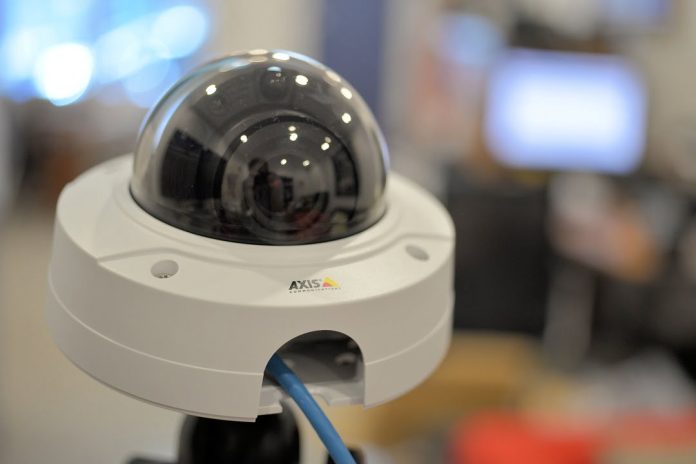AXIS P3225-LV is a 60ips 1080p fixed dome camera with a 1/2.8-inch sensor, a 3–10.5mm f1.4 varifocal lens with remote zoom and focus, Zipstream for bandwidth and storage reduction, 25m OptimisedIR range, IP52-rating for dripping water and dust resistance, and IK08-rating for impact-resistance.
AXIS’ P3225-LV Dome Camera bundles all the company’s goodness into a mid-sized fixed dome. Before I start droning on about specifications I’d like to point out right at the start that making Axis cameras work across networks is absolute bliss. Connect it to your PoE switch, wait a polite length of time for things to power up, hop into network in your directory, double click the Axis camera and hooray, you’re into live view and/or setup.
This camera is full day/night but it also packs 25 metre LED range thanks to 3 compact 850nm IR LEDs, giving more flexibility when it comes to challenging applications. According to Axis, the OptimizedIR, automatically adjusts to the zoom level set at installation, ensuring an evenly illuminated image. Installation aids help with setup of the adjustable IR illumination angle and intensity but I found the default settings to be adequate for my test.
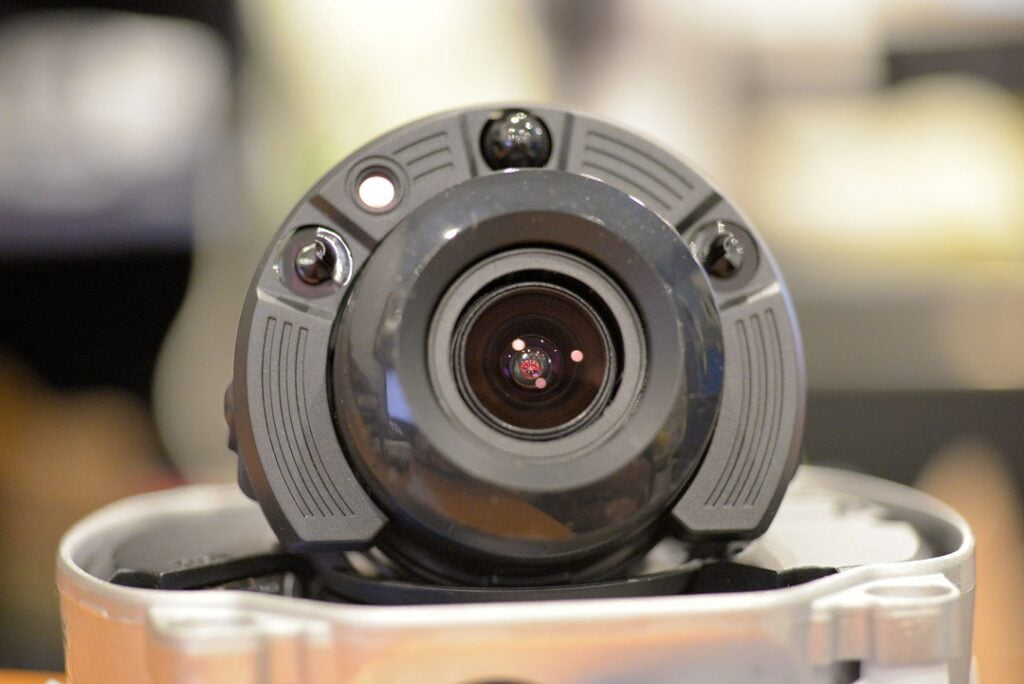
In the cockpit is a progressive scan RGB CMOS 1/2.8-inch sensor, the lens is an f1.4 varifocal 3–10.5 mm, with a horizontal angle of view between 92–34 degrees and a vertical angle of view 50-20 degrees. Minimum scene illumination in colour is 0.25 lux at an aperture of F1.4, and with the cut filter out of the way that goes down to 0.05 lux at F1.4 in monochrome and 0 lux with the IR activated. Shutter speeds range from a supersonic 1/142850th of a second to a creative 2 seconds – the latter of which could be useful for situational awareness of static scenes in very low light. Camera angle adjustments include a pan of 180 degrees, a tilt of -5 to +75 degrees, and a rotation of 95 degrees.
The outer housing is tough cream poly and there’s an aluminium inner camera module with encapsulated electronics. The camera is IP52-rated, IK08 impact-resistant and is dehumidifying with an operating range between 0-50 degrees C. Considering these specifications, this camera is designed to be installed internally, though it could handle being under a roofline if carefully installed.
The camera feels well-made but is not overly heavy at 580 grams and while it’s compact, this is not a tiny unit. Height is 101mm and diameter is 149mm. Power over Ethernet is IEEE 802.3af/802.3at Type 1 Class 3, with a maximum draw of 10.2W and a typical draw of 3.9W. Port choices are simple – there’s one RJ45 10BASE-T/100BASE-TX PoE port for comms and the camera also supports MicroSD, microSDHC and microSDXC cards, as well as remote network area storage.
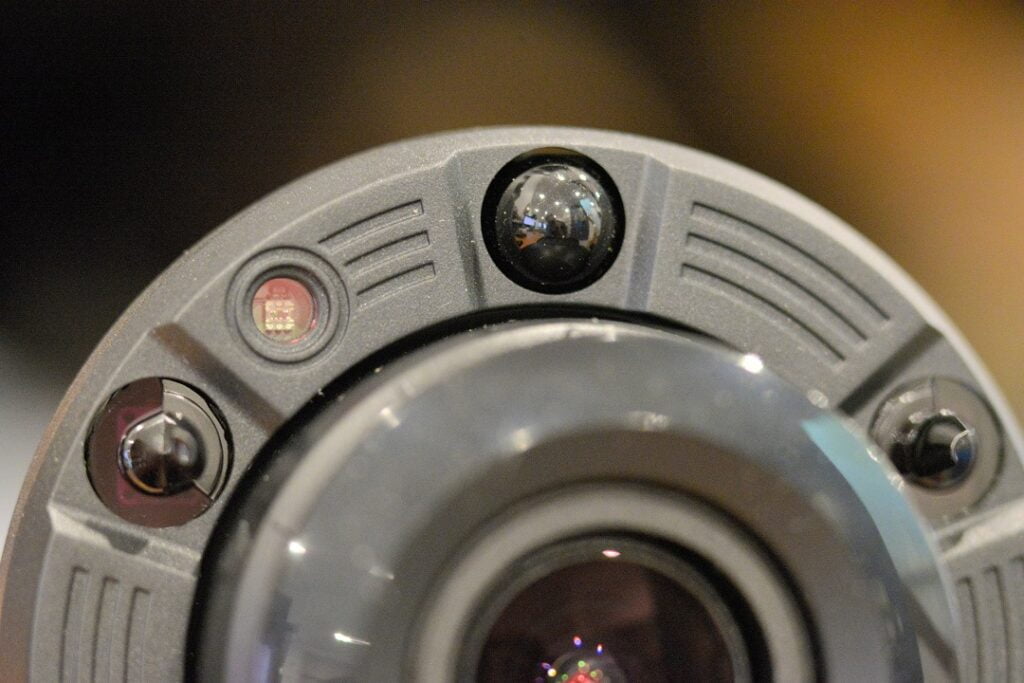
Resolution is selectable between 1920 x 1080 pixels and 160 x 90 pixels and frame rate and bitrate are also controllable. Compression options include H.264 baseline, main and high profile (MPEG-4 Part 10/AVC). When it comes to compression, the biggest deal with this camera is Axis’ Zipstream technology – it really does make a difference to H.264 streams. Meanwhile, WDR – Forensic Capture increases forensic usability by highlighting details in both dark and well-lit areas.
Running the show is your choice of Axis Video Hosting System (AVHS), Axis Camera Companion, Axis Camera Station and ONVIF Profile S. When it comes to analytics there’s video motion detection and active tampering alarm onboard and the camera will report events with pre-alarm and post-alarm video buffering to FTP, SFTP, HTTP, HTTPS, network share and email. Axis cameras are supported by all third party VMS solutions, as well as many DVR and NVR manufacturers.
Test driving the Axis P3225-LV
Our test bed is the usual dedicated Dell 9020 server with i7-4770 quad-core processor with 8 threads per core offering a base clock speed of 3.4GHz and 8GB of RAM. We have an AMD Radeon R7 250 graphics card with 2GB of RAM taking care of video – this is plenty enough for what we’re doing today. We’re using a Netgear GS108P ProSafe 8-port Gigabit switch with 4-port PoE for power and comms. Other cameras on the network today include Panasonic’s WV-SPV7811 4K bullet, an Axis M1125 and the 1080p Uniview Starlight, both the latter of which we’re using to test Fujinon lenses. Neither of these 3 cameras is being recorded live.
The first thing I do once the camera is up on my monitor is dive into Setup. Settings variously include compression, colour, brightness, sharpness, contrast, white balance, exposure control (including automatic gain control), date and time, events, recording, live view config, IVA settings, and all the network and compression settings you might need. It’s all very easy but as usual, it takes me till I’m halfway through the test before I discover how to display the time, which doesn’t automatically appear when you sync time to the workstation.
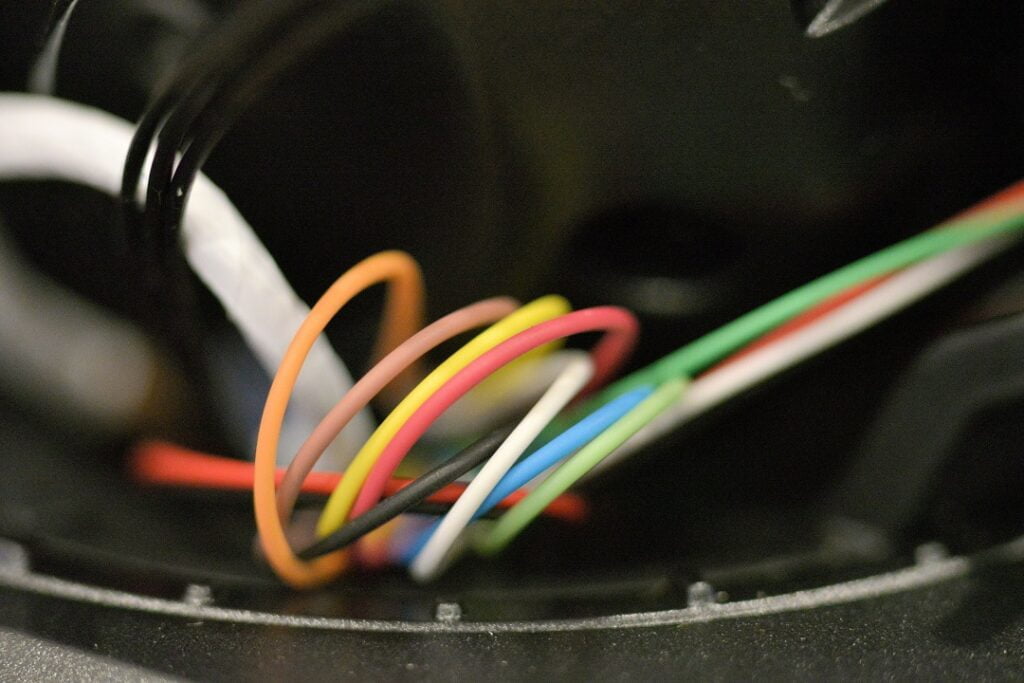
I make a few setting tweaks – I go to 60 per cent for colour – Zipstream is set to low by default and leave it there – I want the benefit but don’t want to lose too much detail – bear this low setting in mind when looking at the bitrate numbers. I’m viewing in H.264 at 25ips. I’ve tweaked the low light priority a third of the way back towards low noise from motion blur. My initial impressions with a quick movement test are that motion blur with this camera is low and I’m keen to keep noise down, too. WDR and white balance are all on auto. My low light max shutter speed is at 1/25 sec which is not ideal for freezing quick human movement but is likely to be ok for faces sauntering towards the lens.
The first internal view of the camera wide open under LED lights. Colour rendition is strong. There’s a little in the way of CAs around light fittings but a good view, generally. Latency seems around 300ths of a second – maybe a little less – that’s very nice work. Barrel distortion is probably around 8-9 per cent wide open, which is about right for a 3mm focal length. Bitrate numbers in here are as low as 300kbps with an average of about 500Kbps – this is excellent performance for a camera that offers this level of detail. Very impressive stuff, this Axis Zipstream.
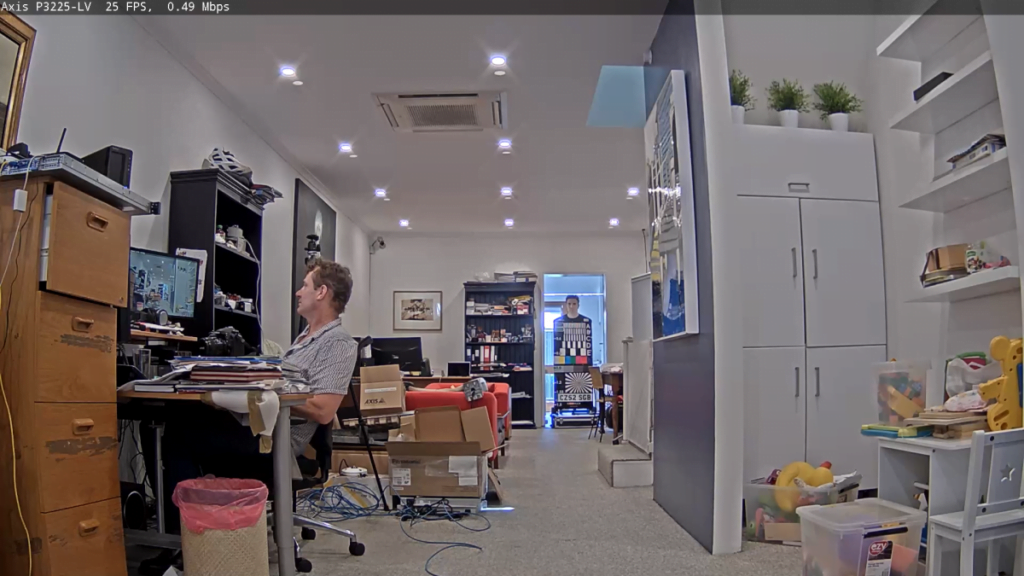
While inside I decide to quickly run my WDR test and discover that performance is very composite. First, I adjust the focal length to around 6mm. Looking down the office I can see all the way through the glass door to the fence. Peak CAs and WDR noise occur with Norman in the doorway to the kitchen and once he’s at the back door, things even out from front to rear of the scene. This camera handles 80,000+ lux extremely well, passing our WDR test with flying colours.
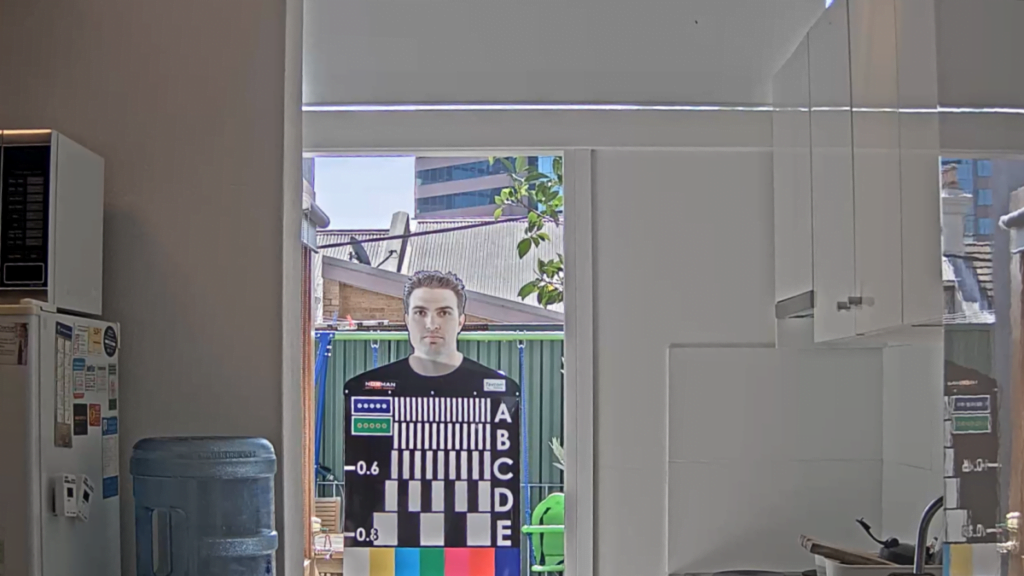
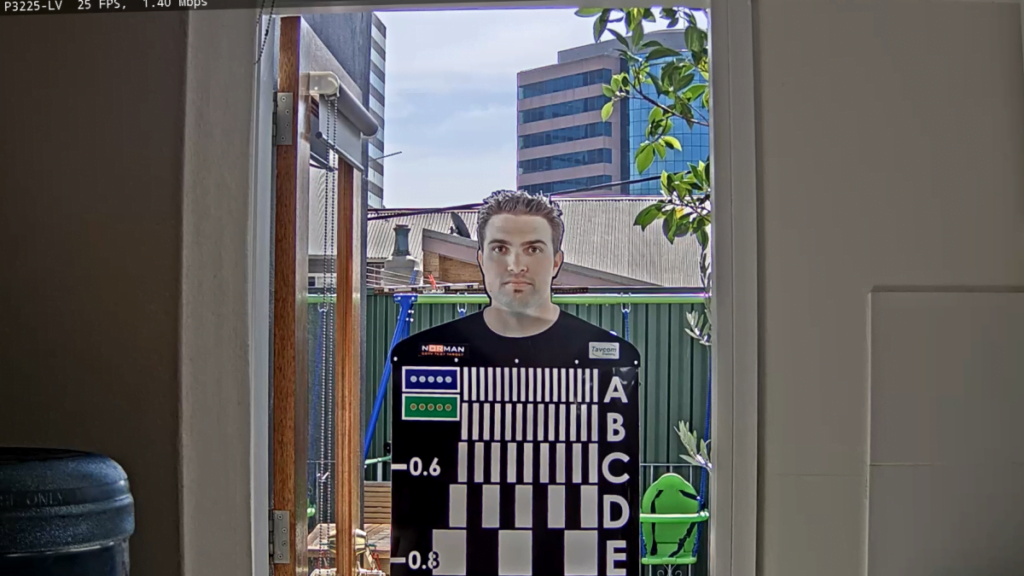
Next, I cart camera and tripod out into the courtyard and set up. It’s bright and hot out here – and windy, too. There’s about 12-15 knots of swirling wind, which is causing the bitrate to spike as trees and bushes in the field of view flail around. Between gusts bitrate falls under 1Mbps and at other times it’s up over 3Mbps. The tree movement allows me to get a clear sense that the P3225-LV resists motion blur well at default settings in good light.
Heading back inside I go full wide to view the entire district scene and this tough application manages to provoke some shimmery flare and a little diamond aperture ghost in the magnesium fluoride coated lens. Important to point out here, my setup sees the dome reversed on a tripod with the tripod ballhead tilted downwards. This is an uncommon application, though wall-mount horizontal dome installations are often seen.
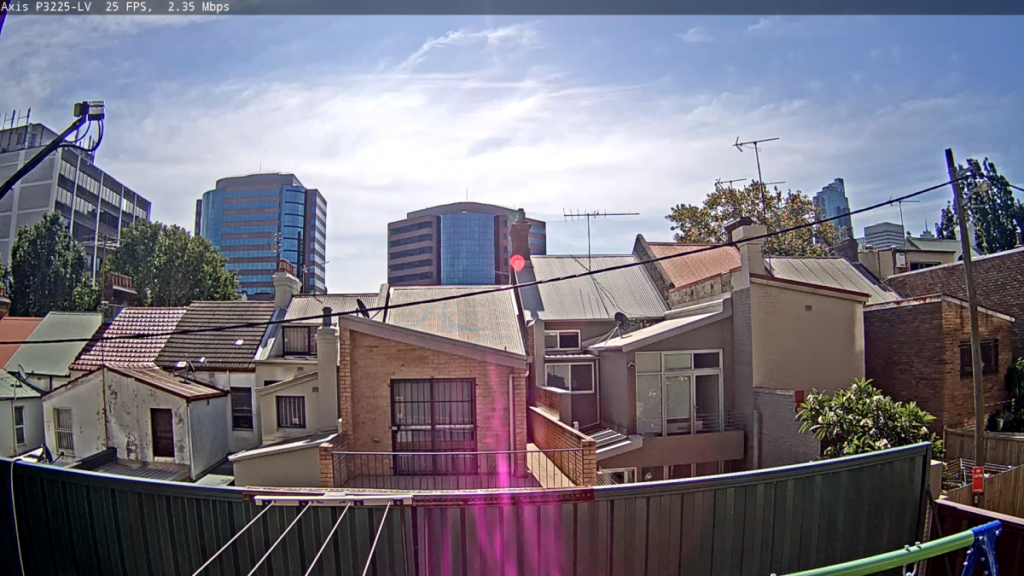
Next, I go back inside and wind the lens out to 6mm and swing the ballhead down so we’re viewing the lane. What are SEN’s first impressions? Solid against backlight, too easy to set up, wonderful fast zoom and focus via the camera browser, Zipstream compression really is great even on the lowest settings – we can confirm that once again – but the big strength I see so far seems to be high contrast and natural colour rendition that offer high levels of detail at 1080p. At mid zoom settings in full sun, this Axis P3225-LV dome camera is looking very nice indeed and at full zoom detail is superb with face recognition out past 16 metres. Bricks and Besser blocks in adjacent walls look 3 dimensional in these conditions.
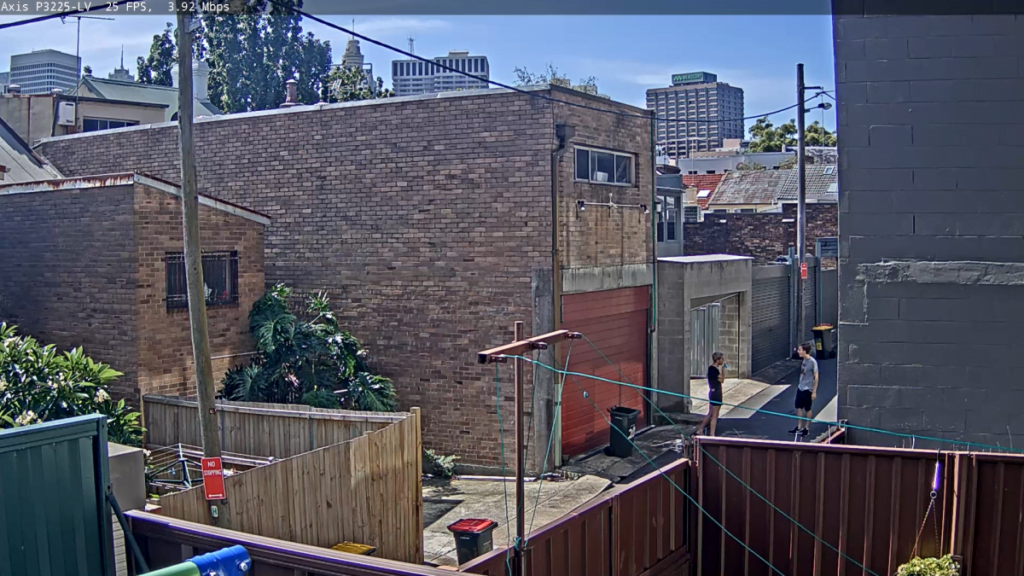
Something I want to talk more about is the P3225-LV’s remote zoom and focus. This capability is great given it means there’s no need to muck around twiddling zoom and focus lock screws before, during and after commissioning. But what’s more interesting to me is that Axis’ zoom and focus is bloody fast. With some cameras I find myself hitting autofocus and going away to make a cup of tea. There’s plenty of time for it to steep as the camera trundles its elements all the way out and all the way back in, then all the way out and all the way back in again. With this camera I can zoom into a scene and jag face recognition in about 20 seconds or so, which is great for real time monitoring.
The image stream remains consistent throughout the afternoon. Levels of detail are extremely high – there’s none of the heavy shadow in corners when faced with backlight with this camera that you sometimes see. As the evening starts leaning in there are changes to the image. For one thing, depth of field opens up as ISO levels increase – I can now read the Memocorp label on a tower on Oxford St 1000m away. The longitudinal chromatic aberrations that I noticed earlier on around high contrast points and lines remain – these are evidenced through the branches of trees against the sky and in the scene overlooking the lane on the edges of buildings and sky – I can’t see them within the scene and they are not intrusive.
My estimation of barrel distortion is under 5 per cent at a 6mm focal length, which is very good. While I’m looking at the camera someone runs up the lane showing there’s almost no motion blur in this light, I later see there’s a little more blur with cars but overall the Axis P3225-LV shrugs off motion blur very competently – that’s a lovely characteristic for a camera to have. During the afternoon, people meet in the lane, giving me a chance to assess face recognition performance. Having remote zoom and focus is great in this respect. If an operator notices an event, in they zoom.
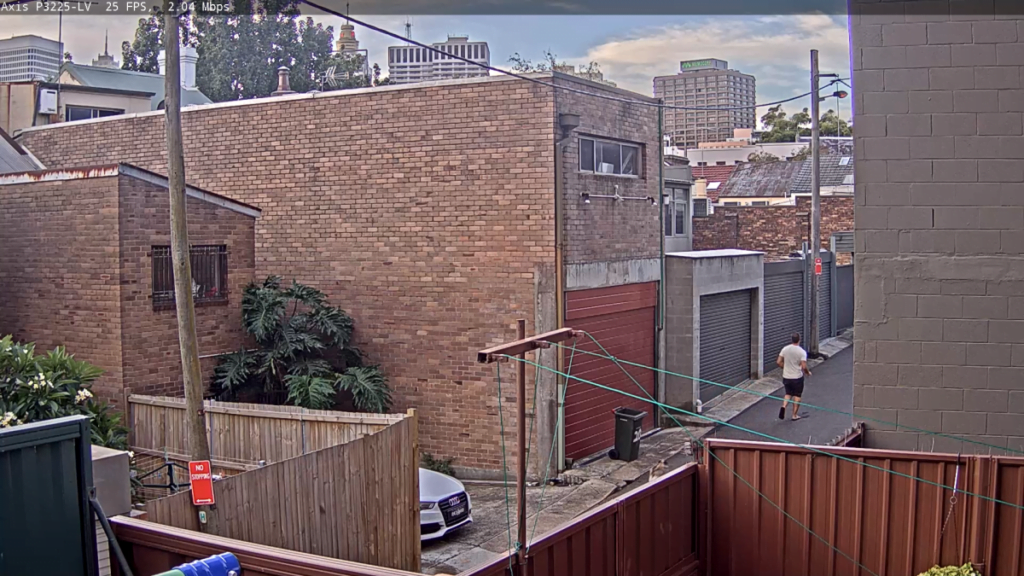
As the scene starts to darken, low light performance through that smoked dome is of particular interest to me. At around 745pm noise starts to become obvious in this scene – as does digital noise smoothing. The image starts to swim a little as light at the lens dips under 10 lux. Situational awareness remains reasonable but the camera is working for it. There’s also some flare from the lens or the dome bubble, as well as the occurrence of a ghost in the foreground of the scene. In neither case do these impinge on the image and they’d be much less likely to appear were the dome was installed facing downwards as it typically would be.
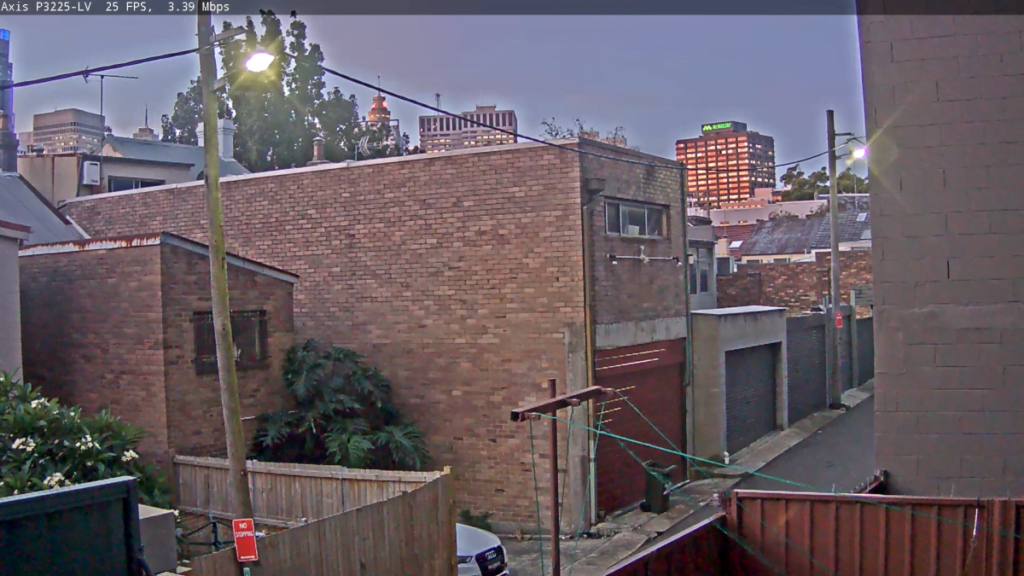
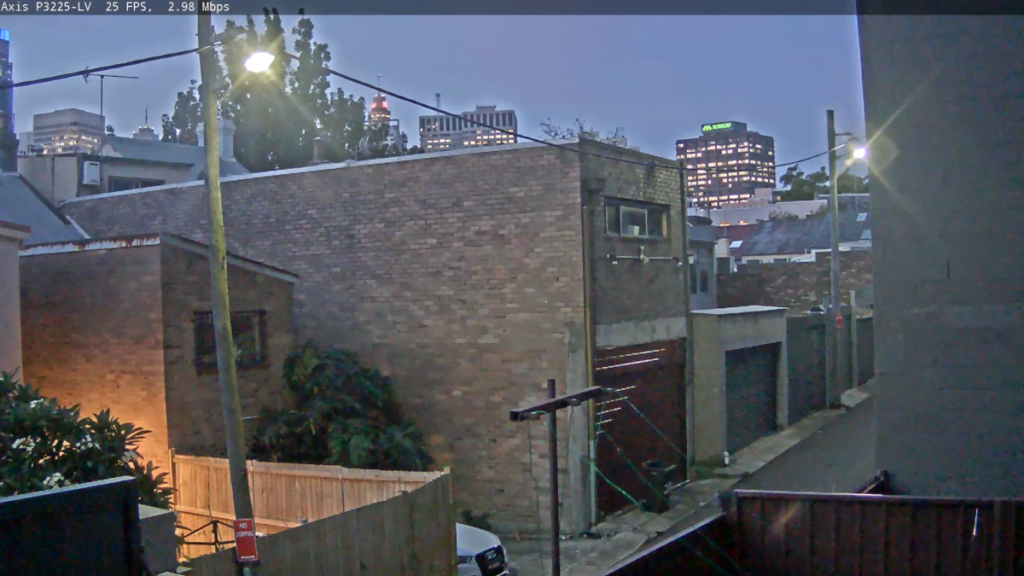
At 8.03pm light at the lens is down to 1 EV – the image remains in colour – there’s flaring around the streetlights in the lane in a diamond aperture shape and some veiling flare in the image but bitrate is only 1.15Mbps at this low Zipstream setting, which is excellent. I notice I can still read the green neon MEMOCORP on the building up the hill and see a star in the sky. There’s still situational awareness in this scene. Not face recognition but there would be no problem at all seeing the context of an incident in the lane, following the action and identifying build, hair colour and clothing colour. This is good performance from a dome camera wearing sunglasses.
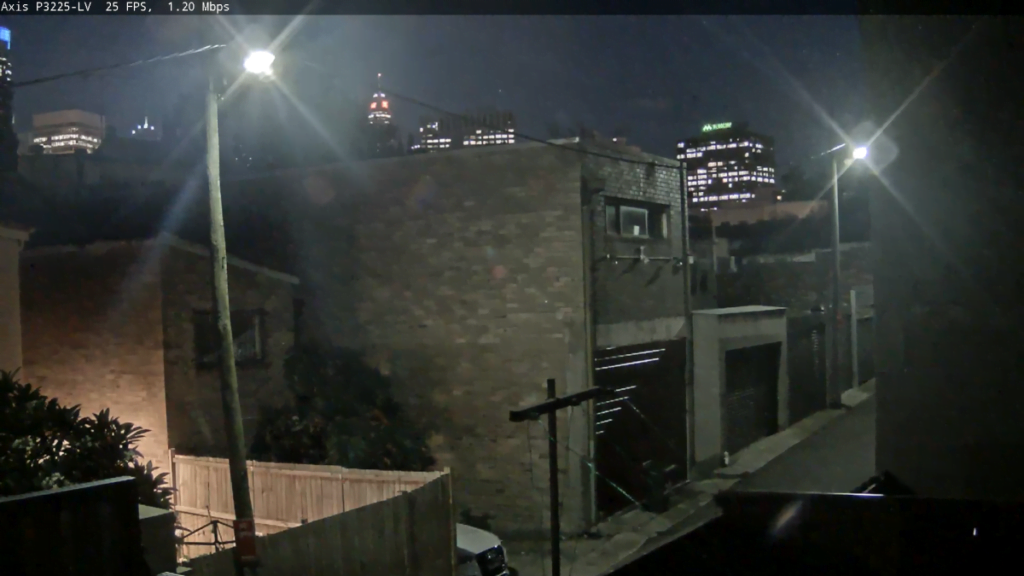
From about 815pm onwards, there’s less than 2 lux at the lens and the camera stays in colour – I’m going to have to force it into night mode if we are to see IR performance. Once I do this, I find night mode IR performance is pretty good – it’s definitely up around 20m and is quite strong closer to the lens. IR definitely fills in the gaps you can get in areas of shadow when a camera stays in night mode. Outside of the meat of the IR spread, the camera is still picking up situational awareness in part thanks to a fairly standard 1/25 sec default shutter speed for low light – you can go lower than this but it’s not advisable if your scene has movement in it.
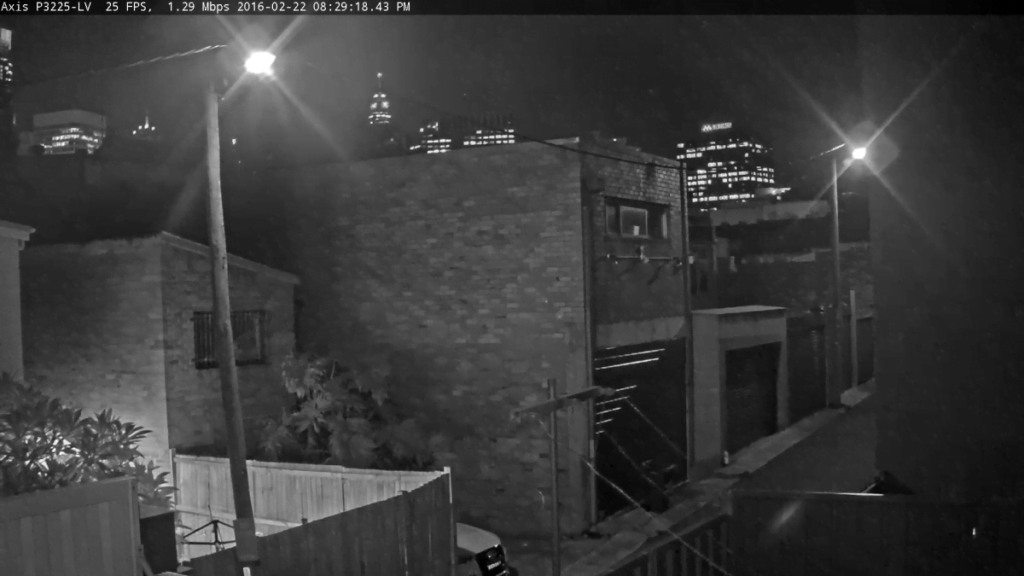
Moving into the office still in night mode I turn off all my screens but the workstation monitor that’s tilted away from Norman. The IR performance is strong in this 12m target area, and gives surprisingly high levels of contrast out to about 7 metres – you get easy face recognition – though at the back of the room Norman’s plastic coated face is lost to flare.
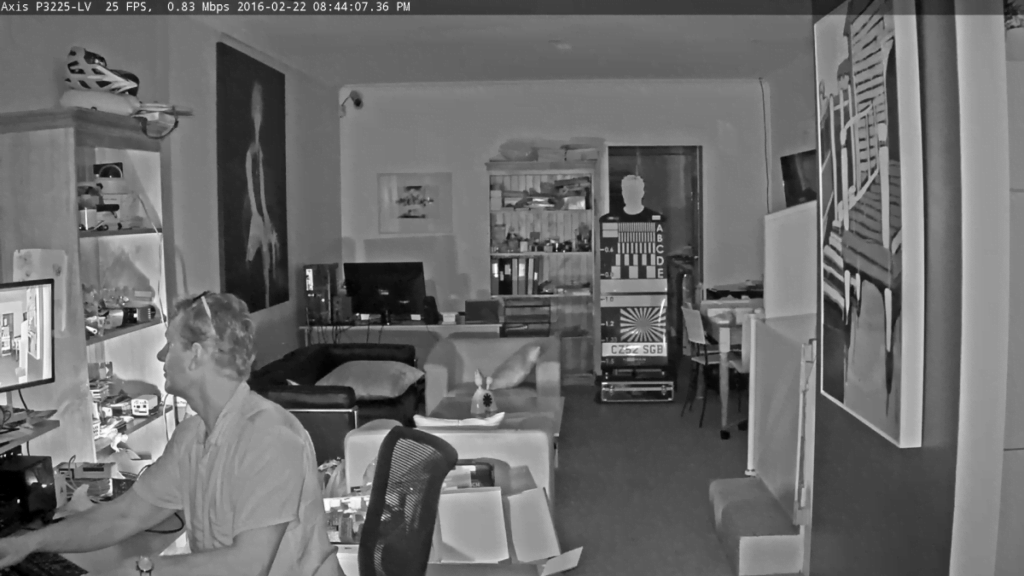
Next, I head out the front. The performance of the camera externally at 7 lux under low pressure sodium is generally strong. There’s some noise in this scene and there’s a little motion blur in darker areas but generally, both these properties are well controlled, considering the nature of the camera – that smoked dome must be adding several stops of aperture – even 1 extra stop is loads at 7 lux – that’s a 50 per cent reduction in light reaching the sensor.
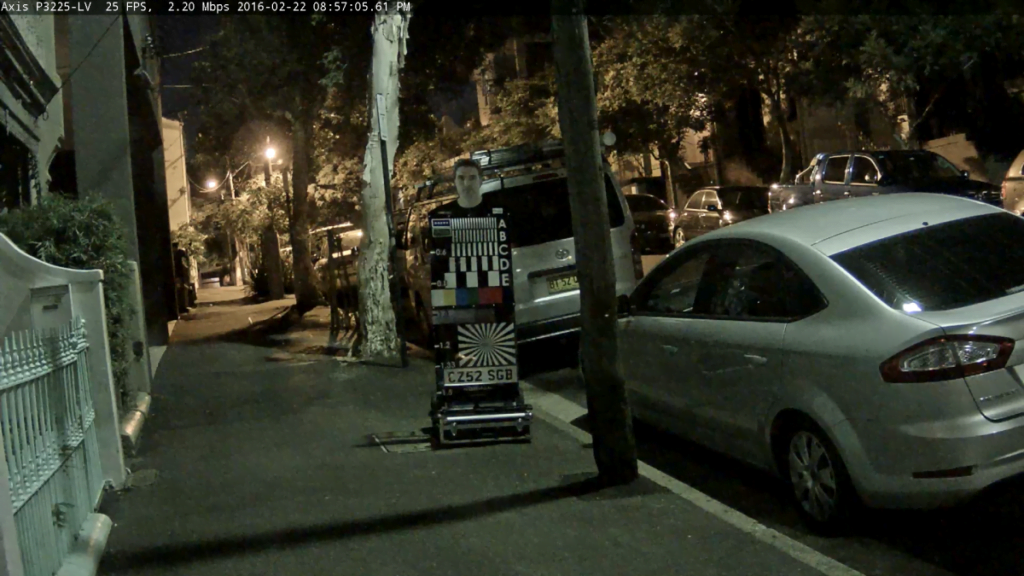
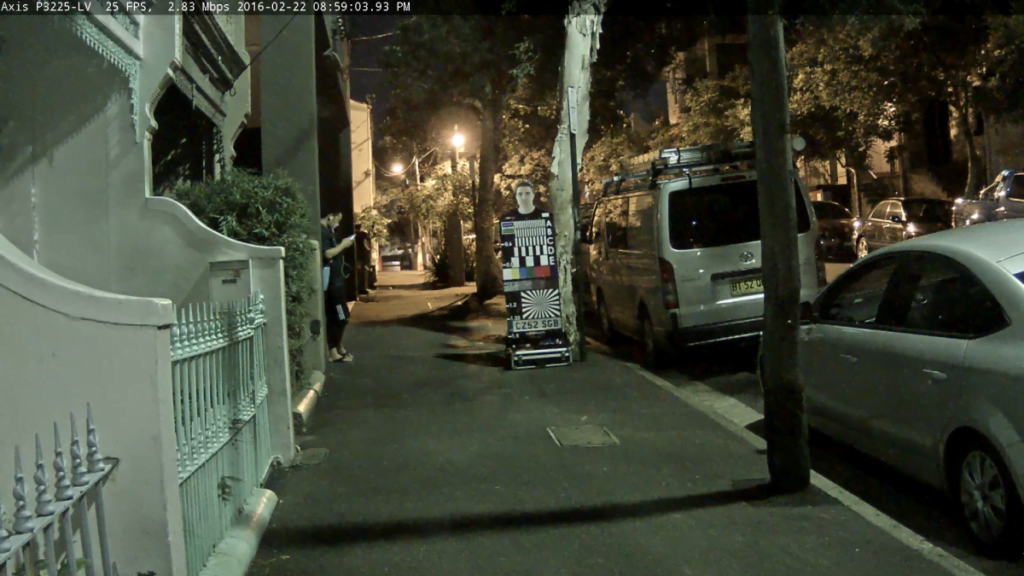
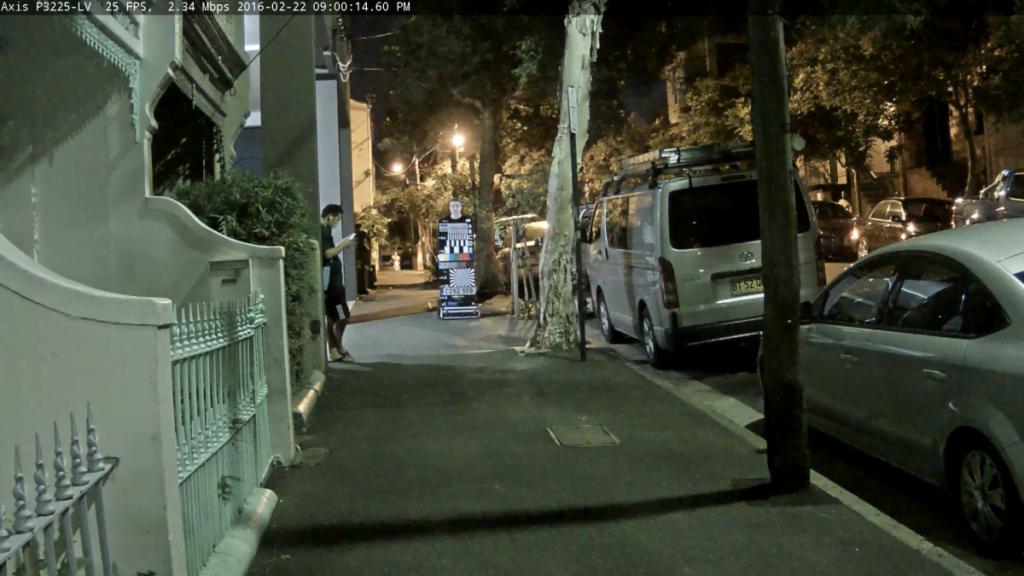
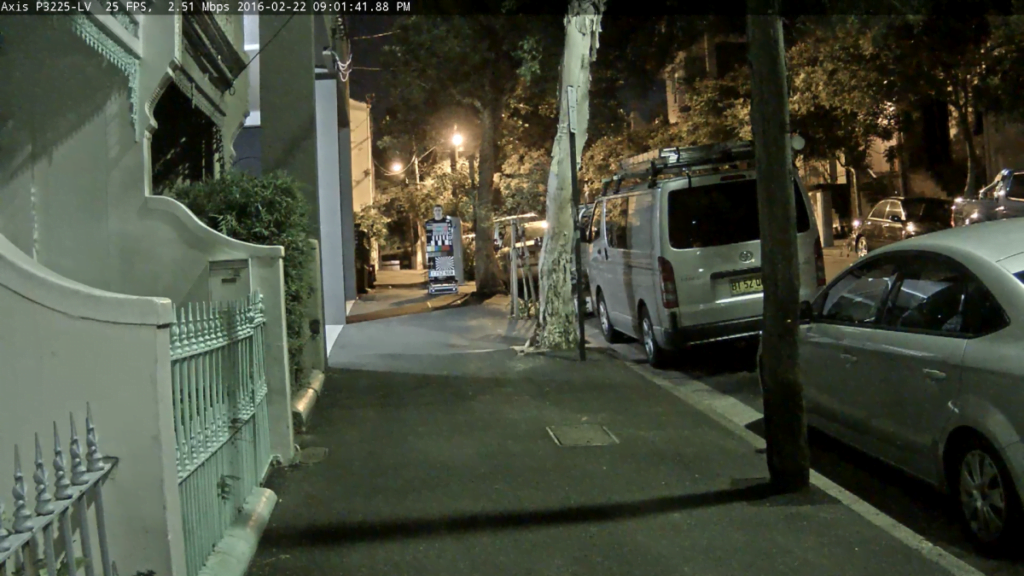
Moving Norman to 12m, then 16m, then 22m, I’m not sure where I lose court admissible face recognition – it’s definitely still there are 12m and again at 16m and very close at 22m, it’s certainly possible to recognise/confirm a known person at 22m. From the C-line down there’s good contrast and colour rendition is still quite strong at 22m. When I about-face Norman and turn the camera down the hill, depth of field is unusually good. Resistance to motion blur at night in this application is very good – I jag images of identifiable cars whizzing down Foveaux St with an ease I’m often no able to with other cameras. You’d have to assume elevated shutter speed is the key here and Axis has done its homework when it comes to balancing conflicting qualities. This camera view also highlights the useful depth of field and the high levels of situational awareness.
The following morning, I head out front to check the performance in bright street conditions. Here, the camera shows its all-round capabilities, doing well with backlight and having no trouble with flare, despite facing direct sunlight. Colour rendition is good, performance in and out of deep shadow is strong, too.
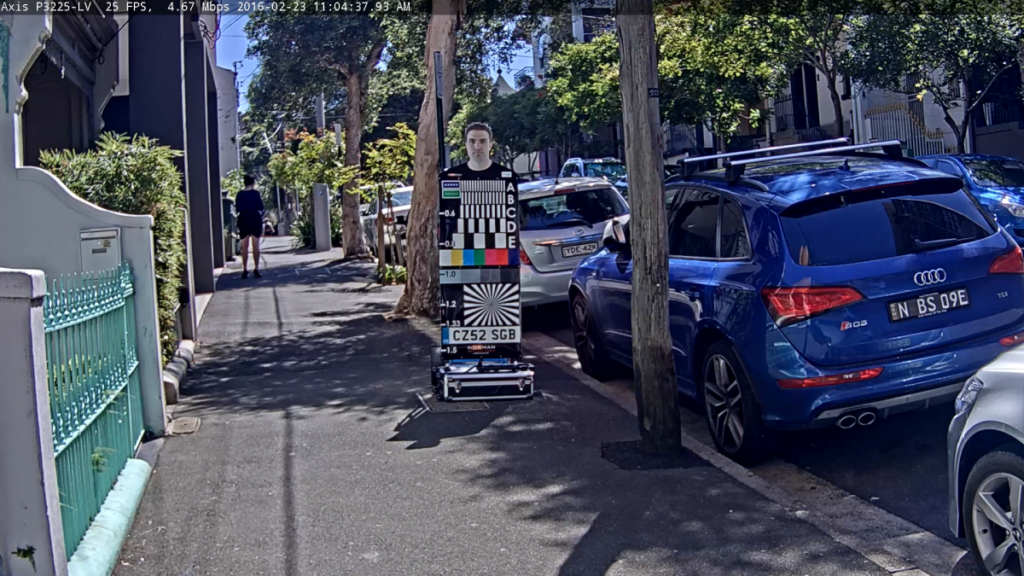
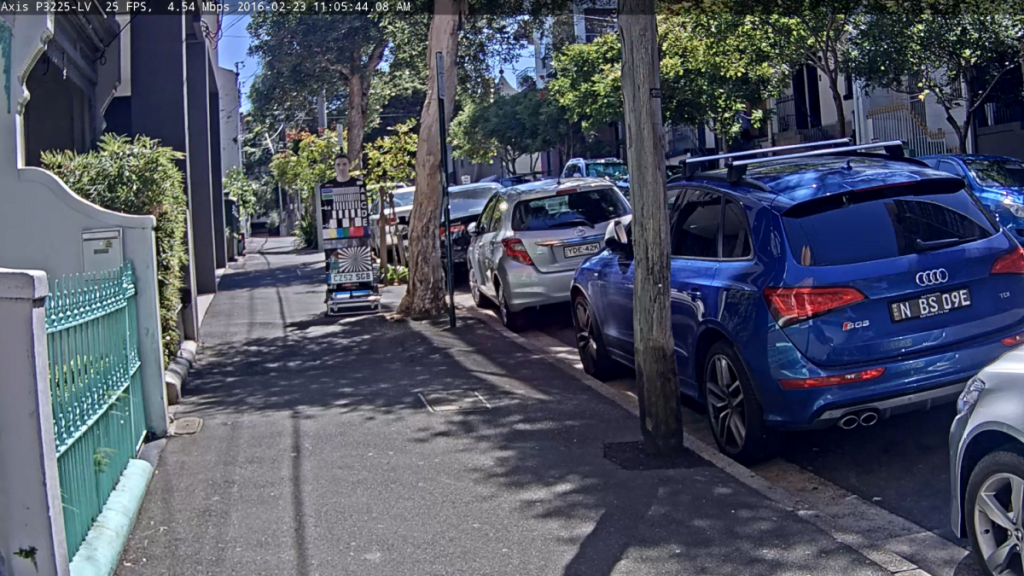
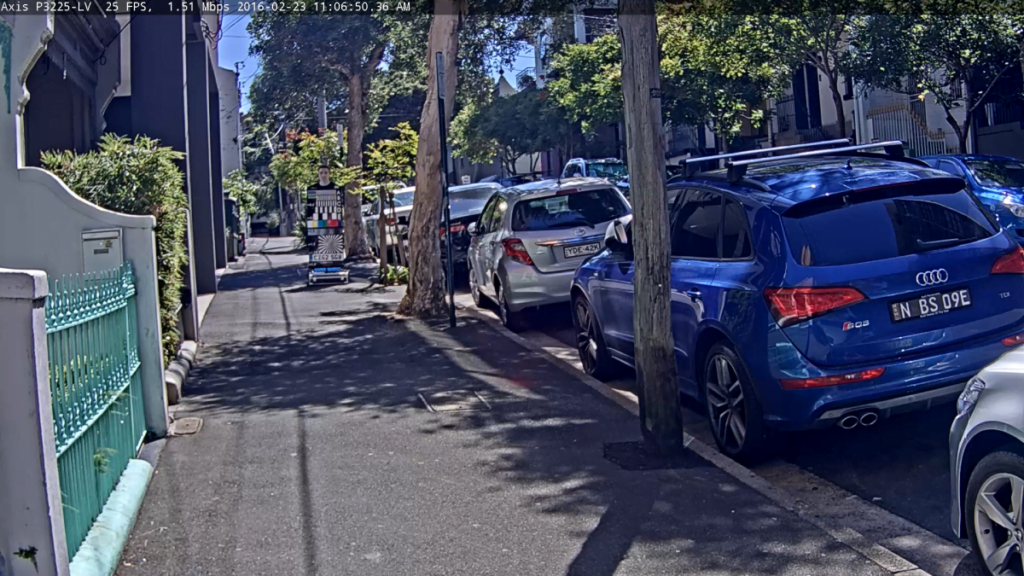
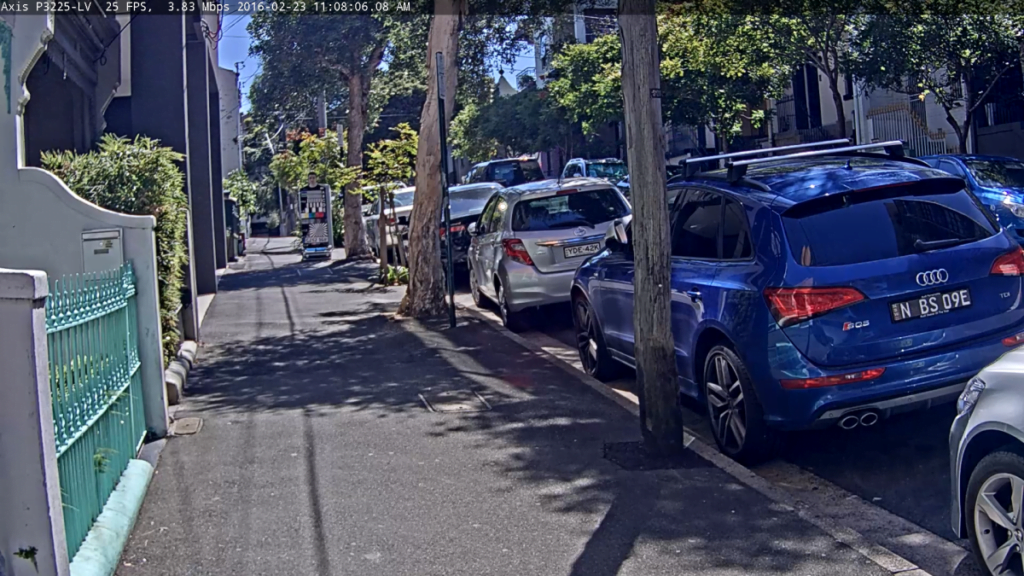
Face recognition is excellent at 8m – the entire target is well rendered – and you really don’t come to the edge of face recognition until 16m – both the 12m and 16m scenes put Norman’s face into shade and that makes a difference. The target shows contrast from the B-line down at 16m and the C-line at 22m, with good license plate recognition at 16m and the ability to roll in one click of the mouse wheel at 22m and make out the license plate.

Looking down the street 80 metres to Foveaux St, resistance to motion blur during the day remains excellent. I see very few signs of chromatic aberration out here and distortion levels at 6mm are so low as to be undiscernible to my eye. When it comes to pedestrian traffic skin tones are very true and the low motion blur makes face recognition extremely easy. There’s no sign of smearing or blocking – I have the shutter speed set to auto and the camera is handling light and dark very well – perhaps shutter speed is at 125th or 150th of a second in this light. Bitrate is low for a street scene – it’s around 2Mbps looking down the hill, though it got higher looking through wind-blown branches looking back the other way.
Conclusion
The AXIS P3225-LV is a fine mid-size dome camera for internal and covered external applications – it carries out its duties as an all-rounder with real aplomb. It offers situational awareness to 80m in daylight and at night in around 7 lux, it pushes out past 40m. In patchy light in the back lane with sub-2 lux at the camera, It gives situational awareness up to 40m and at ranges up to 25m its integrated IR LEDs allow it to handle no light at all. Internal IR performance is excellent, delivering levels of contrast and associated acuity I’m not sure I’ve ever seen before. In terms of WDR performance, this camera handles backlight extremely well and its resistance to motion blur is noteworthy and valuable to any serious security application. Setup is silly easy.
No account of the P3225-LV would be complete without recognition of Axis Zipstream compression. I keep Zipstream at its lowest (least compressive) settings throughout this entire test, and see no impact on image quality and note considerable improvements in bitrate over other H.264 streams. Zipstream is particularly good with static scenes, or scenes incorporating small amounts of movement and while our chosen settings take biterate under 1Mbps internally, you can get bitrate of static scenes down under 100Kbps inside and outside using the highest Zipstream setting. ♦
You can find out more about the AXIS’ P3225-LV network camera here, or read more SEN news here.
By John Adams
Features of the AXIS P3225-LV include:
* 1080p resolution at 60ips
* Remote zoom and focus
* WDR -Forensic Capture
* OptimizedIR illumination
* Axis’ Zipstream technology
* MicroSD, microSDHC, microSDXC.



